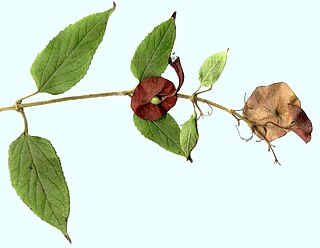Grias cauliflora, the anchovy pear, is a fruit native to Jamaica, Central America, and Colombia. It is often found near rivers or marshes in large colonies. It grows on the evergreen tree Grias cauliflora of the Lecythidaceae family.
Lasiocroton is a plant genus of the family Euphorbiaceae first described as a genus in 1859. The genus is endemic to the West Indies.
- Lasiocroton bahamensisPax & K.Hoffm. - Bahamas, Cuba, Haiti
- Lasiocroton fawcettiiUrb. - Jamaica
- Lasiocroton gracilisBritton & P.Wilson - SE Cuba
- Lasiocroton gutierreziiJestrow - Cuba
- Lasiocroton harrisiiBritton - Jamaica
- Lasiocroton macrophyllus(Sw.) Griseb. - Jamaica
- Lasiocroton microphyllus(A.Rich.) Jestrow - Cuba
- moved to other genera (Bernardia Croton Leucocroton)
- Lasiocroton cordifoliusBritton & P.Wilson - Leucocroton cordifolius (Britton & P.Wilson) Alain
- Lasiocroton prunifoliusGriseb. - Croton punctatusJacq.
- Lasiocroton subpeltatusUrb. - Leucocroton subpeltatus(Urb.) Alain
- Lasiocroton trelawniensisC.D.Adams - Bernardia trelawniensis(C.D.Adams) Jestrow & Proctor
Bernardia is a plant genus of the family Euphorbiaceae first described for modern science as a genus in 1754. It is native to North and South America, as well as the West Indies.

Tetracoccus is a plant genus under the family Picrodendraceae. Shrubby-spurge is a common name for plants in this genus.
Podocalyx is a plant genus under the family Picrodendraceae described in 1841. It is the sole genus in the subtribe Podocalycinae. There is only one known species, Podocalyx loranthoides, a tree native to Venezuela, Colombia, Peru, and northwestern Brazil.

Tillandsia excelsa is a species in the genus Tillandsia. It is native to Central America, Cuba, Jamaica, and the Dominican Republic.

Holmskioldia is a genus of flowering plants in the mint family, Lamiaceae. It is native to the Himalayas but widely cultivated as an ornamental and naturalized in many places It contains only one known species, Holmskioldia sanguinea, commonly called the Chinese hat plant, cup-and-saucer-plant or mandarin's hat.
Egletes is a genus of flowering plant in the family Asteraceae. It is native to South America, Mesoamerica, and the West Indies, with the range of one species barely crossing the US border into the extreme southern part of Texas.

Halodule is a genus of plants in the family Cymodoceaceae described as a genus in 1841. It is widespread on tropical and semi-tropical ocean shores of all continents except Europe and Antarctica.

Cyclanthus bipartitus a species of plant in the family Cyclanthaceae, first described as a genus in 1824. It is native to southern Mexico, Central America, Trinidad, Windward Islands, northern South America.

Pseudelephantopus is a genus of flowering plants in the daisy family described as a genus in 1792.

Tillandsia balbisiana, common name northern needleleaf, is a species of bromeliad in the genus Tillandsia. This species in native to Mexico, Central America, Colombia, Venezuela, the West Indies, and Florida.

Tillandsia bulbosa, the bulbous airplant, is a species in the genus Tillandsia. It is widespread across Central America, the West Indies, southern Mexico, and northern and eastern South America.

Bixa is a genus of plants in the family Bixaceae. It is native to Mexico, Central America, Caribbean, and South America, and naturalized in other places.

Guzmania monostachia is an epiphytic species in the genus Guzmania. Also known as a West Indian tufted airplant, this species is native to South America, Central America, the West Indies and Florida. The species is also reportedly naturalized in Hawaii.
Tillandsia compressa is a species in the genus Tillandsia. This species is native to Mexico, Colombia, Central America, and the West Indies.
Catopsis floribunda is a species in the genus Catopsis. This species is native to the West Indies, Venezuela, Honduras, Oaxaca, and Florida.
Bulbophyllum pinelianum, the rat-tail orchid, is a species of orchid in the genus Bulbophyllum. It is widespread across southern Mexico, the West Indies, Central America and northern South America. It is also reported from Florida but apparently now extinct in that state.
Macroscepis is a genus of plants in the family Apocynaceae, first described as a genus in 1819. It is native to Latin America and the West Indies.

Dimerocostus is a group of plants in the Costaceae described as a genus in 1891. It is native to Central and South America.










